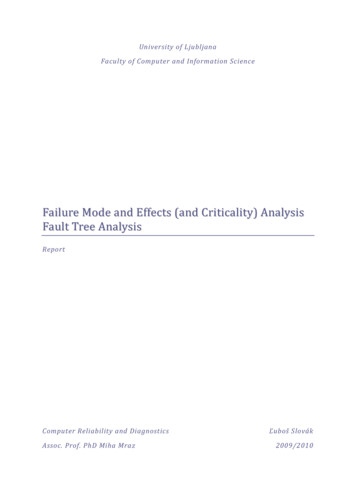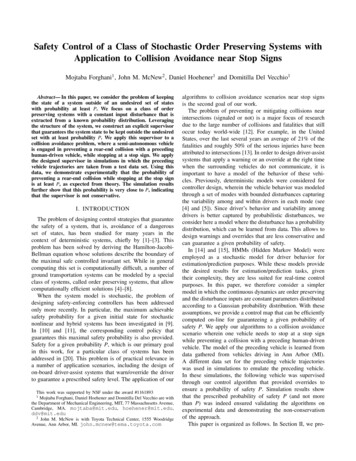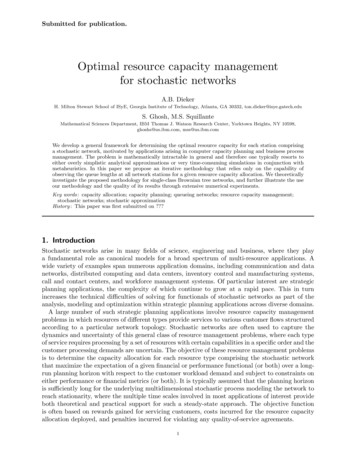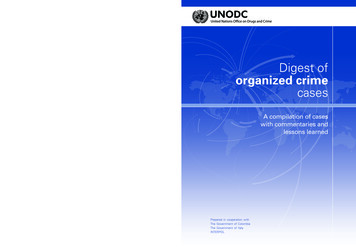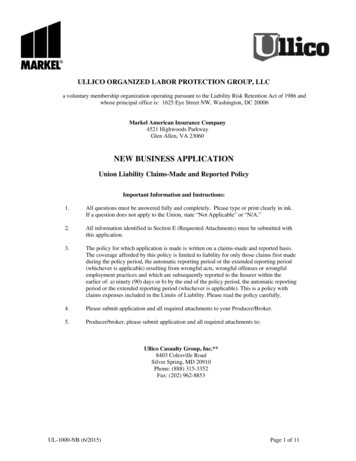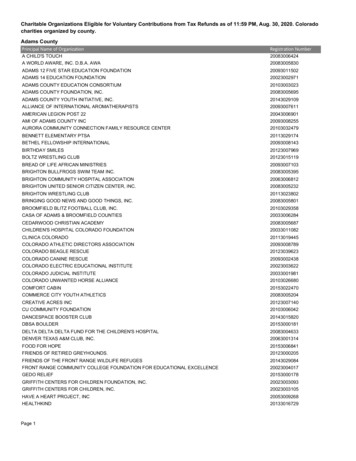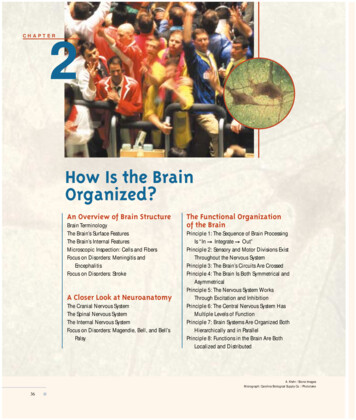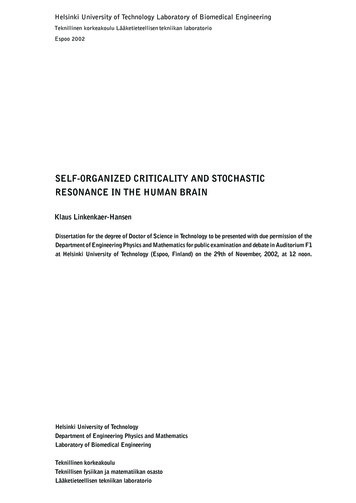
Transcription
Helsinki University of Technology Laboratory of Biomedical EngineeringTeknillinen korkeakoulu Lääketieteellisen tekniikan laboratorioEspoo 2002SELF-ORGANIZED CRITICALITY AND STOCHASTICRESONANCE IN THE HUMAN BRAINKlaus Linkenkaer-HansenDissertation for the degree of Doctor of Science in Technology to be presented with due permission of theDepartment of Engineering Physics and Mathematics for public examination and debate in Auditorium F1at Helsinki University of Technology (Espoo, Finland) on the 29th of November, 2002, at 12 noon.Helsinki University of TechnologyDepartment of Engineering Physics and MathematicsLaboratory of Biomedical EngineeringTeknillinen korkeakouluTeknillisen fysiikan ja matematiikan osastoLääketieteellisen tekniikan laboratorio
Distribution:BioMag LaboratoryEngineering CentreHelsinki University Central HospitalP.O.Box 340FIN-00029 HUS, FinlandISBN 951-22-6216-9 (print)ISBN 951-22-6217-7 (PDF)Picaset OyHelsinki 2002
AbstractThe human brain spontaneously generates neuronal network oscillations at around 10and 20 Hz with a large variability in amplitude, duration, and recurrence. Despite morethan 70 years of research, the complex dynamics and functional significance of theseoscillations have remained poorly understood.This Thesis concerns the dynamic character and functional significance of noninvasively recorded 10- and 20-Hz oscillations in the human brain. The hypotheses, experimental paradigms, data analyses, and interpretations of the results are inspired by recentinsights from physics—most notable the theory of self-organized criticality and the phenomenon of stochastic resonance whose applicability to large-scale neuronal networks isexplained.We show that amplitude fluctuations of 10- and 20-Hz oscillations during wakefulrest are correlated over thousands of oscillation cycles and that the decay of temporalcorrelations exhibits power-law scaling behavior. However, when these ongoing oscillations are perturbed with sensory stimuli, the amplitude attenuates quickly, reliably, andtransiently, and the long-range temporal dynamics is affected as evidenced by changes inscaling exponents compared to rest. In addition to the rich temporal dynamics in localareas of the cortex, ongoing oscillations tend to synchronize their phases and exhibitcorrelated amplitude fluctuations across the two hemispheres, as shown for oscillationsin homologous areas of the sensorimotor cortices. Finally, it is revealed that intermediate amplitude levels of ongoing oscillations provide the optimal oscillatory state of thesensorimotor cortex for reliable and quick conscious detection of weak somatosensorystimuli.We propose that the long-range temporal correlations, the power-law scaling behavior, the high susceptibility to stimulus perturbations, and the large amplitude variabilityof ongoing oscillations may find a unifying explanation within the theory of self-organizedcriticality. This theory offers a general mechanism for the ubiquitous emergence of complex dynamics with power-law decay of spatiotemporal correlations in non-linear selforganizing stochastic systems consisting of many units. The optimal ability to detectconsciously and respond behaviorally to weak somatosensory stimuli at intermediate levels of ongoing sensorimotor oscillations is attributed to stochastic resonance—the intuitively paradoxical phenomenon that the signal-to-noise ratio of detecting or transmittinga signal in a non-linear system can be enhanced by noise.Based on the above results, we conjecture that a mechanism of intrinsic stochasticresonance between self-organized critical and stimulus-induced activities may be a general organizing principle of great importance for central nervous system function andaccount for some of the variability in the way we perceive and react to the outside world.KeywordsNeuroscience; complexity physics; neuronal population dynamics; avalanche dynamics; spontaneous or ongoing oscillations; self-organization; variability; criticality; brain states; stochastic resonance; correlations; scaling behavior.
2List of publicationsThis Thesis is based on the following publications:P1Linkenkaer-Hansen K, Nikouline VV, Palva JM, Ilmoniemi RJ. Long-range temporal correlations and scaling behavior in human brain oscillations. The Journal of Neuroscience,21:1370–1377, 2001.P2Nikouline VV, Wikström H, Linkenkaer-Hansen K, Kesäniemi M, Ilmoniemi RJ, HuttunenJ. Somatosensory evoked magnetic fields: relation to pre-stimulus mu rhythm. Clinical Neurophysiology 111:1227–1233, 2000.P3Nikouline VV, Linkenkaer-Hansen K, Wikström H, Kesäniemi M, Antonova EV, IlmoniemiRJ, Huttunen J. Dynamics of mu-rhythm suppression caused by median nerve stimulation: amagnetoencephalographic study in human subjects. Neuroscience Letters 294:163–166, 2000.P4Nikouline VV, Linkenkaer-Hansen K, Huttunen J, Ilmoniemi RJ. Interhemispheric phasesynchrony and amplitude correlation of spontaneous beta oscillations in human subjects: amagnetoencephalographic study. NeuroReport 12:2487–2491, 2001.P5Linkenkaer-Hansen K, Nikulin VV, Palva JM, Kaila K, Ilmoniemi RJ. Stimulus-inducedchange in long-range temporal correlations and scaling behavior of sensorimotor oscillations.TKK–F–A815 (2002). ISSN: 1456–3320. ISBN: 951–22–6176–6.P6Linkenkaer-Hansen K, Nikulin VV, Palva S, Ilmoniemi RJ, Palva JM. Intrinsic stochasticresonance of sensorimotor processing mediated by ongoing neuronal oscillations. TKK–F–A816 (2002). ISSN: 1456–3320. ISBN: 951–22–6177–4.Contribution of the authorI conceived the original idea and experimental paradigm, conducted the experiments, wrotethe analysis software, analyzed the data, and was the principal and corresponding authorof publications P1, P5, and P6. In publications P2–P4, I participated actively in discussingthe analyses, results, and in writing the manuscript.
3AcknowledgementsThe work for this Thesis was carried out at the BioMag Laboratory at the Helsinki UniversityCentral Hospital. I am indebted to my supervisor Docent Risto J. Ilmoniemi, the head ofBioMag Laboratory, for teaching me good habits of scientific writing and for encouragementand patience with my work. The high technical standards of the laboratory together withRisto’s open mind towards research ideas have made BioMag Laboratory an ideal playgroundfor scientific creativity to flourish. I also wish to thank Prof. Toivo Katila for making thisThesis possible and Acad. Prof. Risto Näätänen for insightful discussions.My closest collaborators, Vadim V. Nikulin and J. Matias Palva, I would like to thankfor sharing the excitement of science, for having made substantial contributions—each intheir very personal way—to my way of thinking of science and the brain in particular, andlast but not least for their friendship.I thank the official pre-examiners, Prof. Juha Voipio and Docent Gabriel Curio, for theirconstructive comments on this Thesis.Over the years, I have had several colleagues that created an enjoyable and pleasantworking environment at the BioMag Laboratory. In particular, I would like to thank SuviHeikkilä, Elina Pihko, Antti Korvenoja, Janne Sinkkonen, Heidi Wikström, Leena Lauronen,Minna Huotilainen, Juha Huttunen, Tobias Andersen, Karen Johanne Pallesen, ChristopherBailey, Martti Kesäniemi, Svetlana Khaslavskaia, Satu Palva, Anna Nikulin, Yury Shtyrov,Dubravko Kičić, Simo Monto, Janne Hämäläinen, Seppo Kähkönen, Anna Mari Mäkelä,Ville Mäkinen, Oguz Tanzer, Eero Pekkonen, Essi Rossi, and Maritta Maltio-Laine.Back ’home’ at the Niels Bohr Institute I have been pleased by the welcoming atmosphereand curiosity for my work. In particular, I would like to thank Per Bak, Preben Alstrøm,Mogens Høgh Jensen, Henrik Flyvbjerg, and Benny Lautrup for inspiring and helpful discussions. Other people from outside of the BioMag Laboratory whom I would like to thank forvaluable discussions are Ole Jensen, Tapio Ala-Nissilä, and Kai Kaila.The daily contact over the e-mail with my friends in Denmark—Kim Højrup, GuggiKofod, Mikkel Nielsen, Søren Guldberg-Kjær, and Leif Oxenløwe—has been a great supportduring the six years of living in Finland. Thanks also go to Henrik Schulz.On the financial side, this Thesis was made possible primarily through two generousgrants from the Danish Research Agency. The support from the Nordic Academy for Advanced Study (NorFA), Center for International Mobility (CIMO, Finland), Helsinki University Central Hospital Research Funds, National Institutes of Health (USA), and TES(Finland) is also gratefully acknowledged.Special thanks go to my parents, ”mor og far”, for their infinite care and genuine interestin what I do and to Morten and Tina.Finally, I would like to express my gratitude to Titia for her love and support and to ourdear son Tigo for making this year the happiest of my life.Helsinki, October 2002Klaus Linkenkaer-Hansen
4CONTENTSContents1 Introduction1.1 Outline of the Thesis . . . . . . . . . . . . . . . . . . . . . . . . . . . . . . . .552 Theories of complexity and the brain2.1 Reductionism and the fragmentation of science . . . . . .2.2 A major challenge for ”brain theory” . . . . . . . . . . . .2.3 Power laws and natural integrity . . . . . . . . . . . . . .2.4 Agent-based modeling: large-scale dynamics ”bottom-up”.66668.101011121213131517173 Overview of the literature3.1 Brain ontogeny and self-organization in neuronal systems3.2 Oscillations and resonance in neuronal networks . . . . . .3.3 Network oscillations at 10 and 20 Hz . . . . . . . . . . . .3.3.1 Low-dimensional chaos in 10-Hz oscillations? . . .3.4 Self-organization and complexity . . . . . . . . . . . . . .3.4.1 Self-organized criticality (SOC) . . . . . . . . . . .3.4.2 SOC in large-scale neuronal activity? . . . . . . . .3.5 Stochastic resonance . . . . . . . . . . . . . . . . . . . . .3.5.1 Stochastic resonance in neuronal activity . . . . .4 Aims of Study185 Materials and Methods196 Summary of publications6.1 Long-range temporal correlations and scaling behavior (P1) . . . . . . .6.2 Pre-stimulus oscillations and somatosensory evoked fields (P2) . . . . .6.3 Reactivity of sensorimotor oscillations to median nerve stimulation (P3)6.4 Interhemispheric phase synchrony and amplitude correlations (P4) . . .6.5 Changes in long-range temporal correlations and scaling behavior (P5) .6.6 Intrinsic stochastic resonance mediated by ongoing oscillations (P6) . .212122232426277 General discussion307.1 Why search for self-organized criticality in the brain? . . . . . . . . . . . . . . 307.2 Possible functional implications if the brain exhibits SOC . . . . . . . . . . . 317.3 Outlook and perspectives . . . . . . . . . . . . . . . . . . . . . . . . . . . . . 328 Conclusion33References34
Introduction15IntroductionThis Thesis concerns the nature of oscillatory activity in the human brain, in particularat 10 and 20 Hz. These oscillations are generated spontaneously in several areas of thecerebral cortex as neuronal networks transiently form assemblies of synchronously firingcells. Sensory input can modulate or induce neuronal activity at around 10 and 20 Hz, but alarge variability in amplitude, duration, and recurrence of these oscillations is observed evenin the absence of such perturbations. This variability has intrigued researchers for morethan 70 years [19,83,92], yet its mechanistic origin and functional significance have remainedpoorly understood.To understand the source of variability in spontaneously generated or stimulus-inducedneuronal oscillations, it seems intuitively natural to investigate the detailed biophysical mechanisms underlying the generation of this activity. Nevertheless, there may be an alternativeapproach. Recent years of research on self-organization and complexity has lead to novelmethods and frameworks for analyzing and interpreting variability per se, which are nowchanging the way complex fluctuations are perceived in many areas of science [12, 27, 56,145]. While previously considered a nuisance or ”noise”, variability is increasingly beingacknowledged as a potentially valuable source of information about the developmental historyand spatiotemporal organization of non-linear dynamical systems.The central premise of the present work is that theories of self-organization, aiming toexplain the often statistically stereotyped variability of structures and dynamics in systemsconsisting of many non-linearly interacting units, may also apply to the dynamics of 10- and20-Hz oscillations in the brain. The most fundamental prediction of these theories is a ”critical” type of dynamics of these network oscillations, which should be reflected in intermittentamplitude fluctuations with a slow power-law decay of the temporal correlations. We furtherhypothesized that the interaction between ongoing and stimulus-induced activities may giverise to stochastic-resonance effects in perception and behavior. Finally, it is conjectured thatnetwork oscillations in a critical state may provide a beneficial susceptibility for the brainto detect weak inputs and to reorganize swiftly from one state to another during processingdemands.To summarize in neuroscientific terms, the aim of this Thesis is to characterize the stateof the brain during wakeful rest, as indexed by 10- and 20-Hz oscillations, and how thisstate is affected by and affects the processing of incoming information from our sensoryenvironment.1.1Outline of the ThesisThroughout this Thesis, I treat the relevance and limitations of certain theoretical frameworks of non-linear dynamical systems, self-organization, and complexity to the field ofneuroscience and review the main results of publications P1–P6.Section 2 outlines one of the greatest challenges for a ”theory of the brain” and its relationship to complexity science. Sections 3.1–3.3 introduce a number of neuro
The human brain spontaneously generates neuronal network oscillations at around 10 and 20 Hz with a large variability in amplitude, duration, and recurrence. Despite more than 70 years of research, the complex dynamics and functional significance of these oscillations have remained poorly understood. This Thesis concerns the dynamic character and functional significance of noninva-sively .
